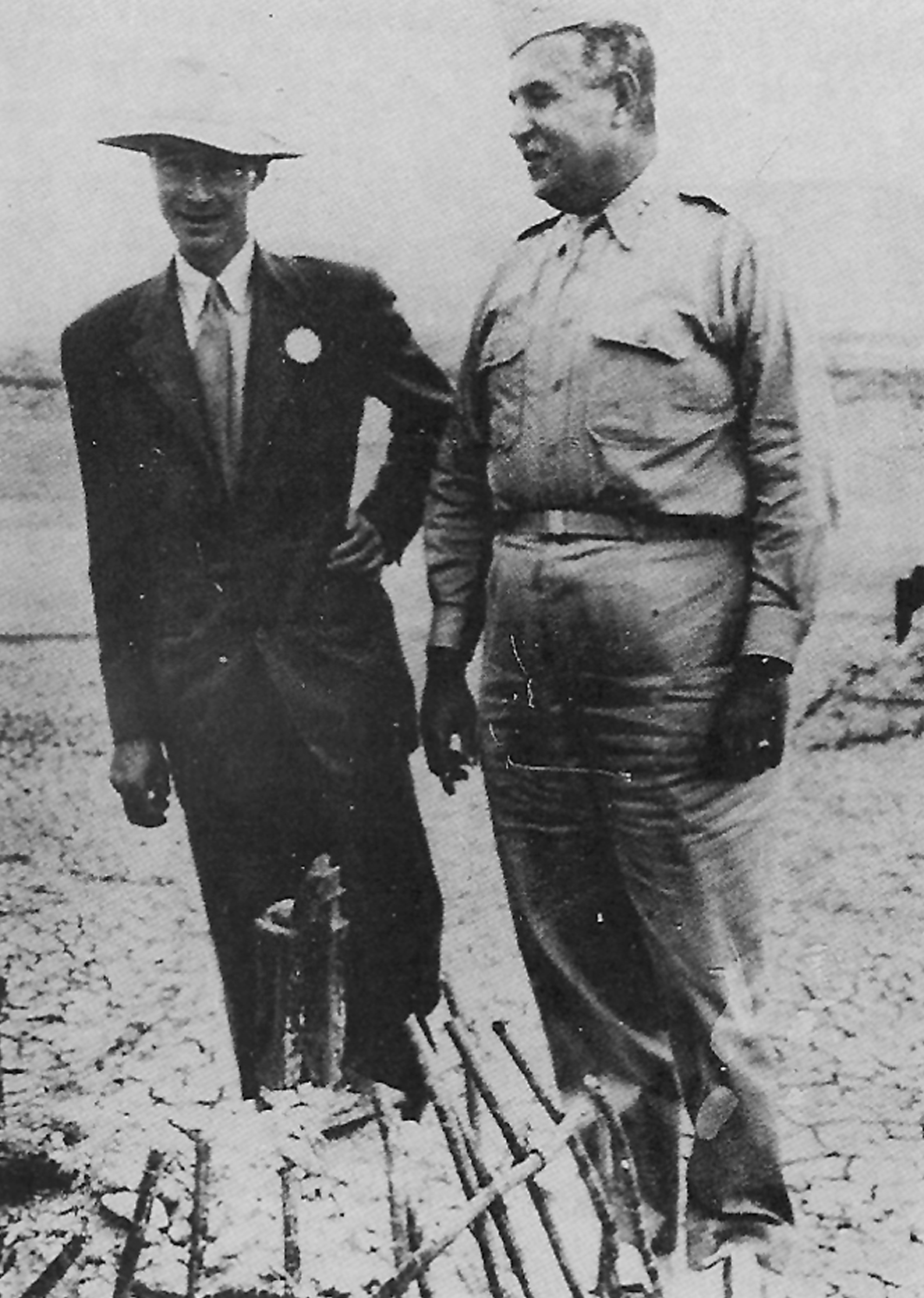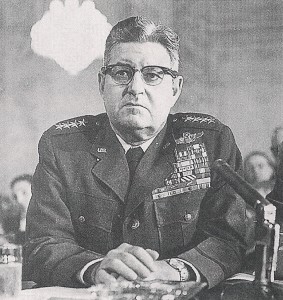By S. Clayton Moore
In late August 1944, while at an Army airfield in Alamogordo, N.M., where he was doing experimental work with the Boeing B-29 Superfortress, Lt. Col. Paul Tibbets received an unexpected call, from the office of Gen. Uzal G. Ent, commander of the Second Air Force, directing him to be in Colorado Springs the following morning.
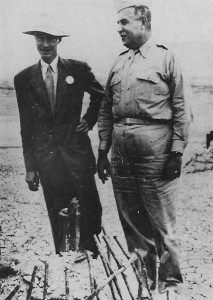
L to R: Nuclear physicist J. Robert Oppenheimer, with Col. Leslie Groves, beside the remains of the tower used to set off the world’s first atomic explosion on the Alamogordo bombing range.
He was told to pack his bag, because he wouldn’t be returning to Alamogordo. He was also supplied one more piece of the puzzle; his new assignment would eventually take him overseas.
On the first day of September, Tibbets winged his way toward Colorado Springs.
After arriving at the office and identifying himself, he was told that Ent was waiting for him, and would soon be available. He was sitting where he could see the general’s door, and it soon opened; he was surprised when a lieutenant colonel, wearing the insignia of the U.S Army Corps of Engineers, walked out.
The man, who identified himself as Jack Lansdale, told him he had some questions for him. After ushering Tibbets into a “cloakroom” for guaranteed quiet, Lansdale told him he was head of security for the Corp’ Manhattan District, and began asking him questions.
“They were all mundane, simple,” said Tibbets.
Then, at one point, Lansdale asks Tibbets if he’d ever been arrested.
“Sure,” Tibbets responded. “My old man was good to me. I had a car, and money to buy the gas and run it. When I had time off from the university, I’d go to Miami, to the beach, spend hours of the evening there, and come back in the early morning hours; the streets would be deserted. I had a heavy foot; I’d step down on it, and the cops would pick me up for speeding.”
After he was done with his explanation, Lansdale said, “Anything else?”
“I knew right then that he had something,” said Tibbets. “I said, ‘Well one night I was at surfside. It was about one o’clock in the morning. The car’s parked, and I’m in the backseat of the car in a compromising position with a young lady.’ He started laughing and said, ‘That’s all I wanted to know.'”
With that out of the way, Lansdale and Tibbets joined Ent, and Lansdale proceeded to tell him he was “perfectly satisfied with Colonel Tibbets.”
Tibbets remained puzzled as to why he was there, and being interrogated, until Ent explained.
Earlier, Gen. Henry “Hap” Arnold, Chief of Staff of the U.S. Army Air Force, had placed a call to Ent, telling him about a list of three men being given serious consideration from which he would need to select one to organize a special unit. Those men included Brig. Gen. Frank Armstrong, Tibbets’ former superior, and Col. Roscoe “Bim” Wilson. Both men, although not chosen for the task at hand, would later be involved with the Manhattan District. The third man was Lt. Col. Paul Tibbets, who, at 29, was the youngest of the three candidates, and whom Tibbets later found out, Ent had immediately given his stamp of approval, telling Arnold he was “the man.”
In March 1943, after flying 25 missions in B-17s, including the First American Flying Fortress raid against occupied Europe, and after leading the first bombardment missions in support of the North African invasion, Tibbets returned to the states to test the combat capability of the B-29, a bomber that would be used by this special unit.
The B-29 had been plagued with problems, including its engine, which had a tendency to overheat on a long flight at high altitudes. Tibbets had flown about 400 hours in tests, giving him more experience as to its capabilities and limitations than any other pilot at that time. He also had demonstrated leadership ability and had a reputation as an independent type of operator. On top of that, he had been helpful in devising many of the bombing techniques being applied successfully in the air war against the enemy.
On that day, Tibbets was also introduced to Dr. Norman F. Ramsey, a former Columbia University professor, and Navy Capt. William Parson, a gun expert. Ramsey explained he was a nuclear physicist, and that he and other scientists of the Manhattan District had been building weapons, at a secret laboratory in Los Alamos, N.M.
“We’ll call them what they are; they’re atomic explosions,” Tibbets recalls Ramsey saying.
He was soon briefed on the role he would play for the “Manhattan Project,” a joint undertaking of the U.S., Great Britain and Canada.
When physicists in the U.S. learned in the late thirties that German scientists had discovered how to split, or “fission,” the uranium atom, releasing nuclear energy, many feared that Hitler might acquire an atomic bomb. Fearing this possibility, Hungarian physicists Leo Szilard and Eugene Wigner, refugees, sought the help of famed physicist Albert Einstein.
In the fall of 1939, President Franklin D. Roosevelt received a letter from Einstein regarding the possibility of developing an extremely powerful bomb. In early October 1941, he approved intensified research into the feasibility of an atomic bomb, although the decision to devote full energy to the bomb’s production wasn’t made until Dec. 6, 1941, the day prior to the attack on Pearl Harbor.
In June 1942, Roosevelt transferred the project to the War Department’s Army Corps of Engineers. To disguise the secret project, the Corps created the Manhattan Engineer District, with headquarters initially in New York City.
Three months later, Maj. Gen. Leslie R. Groves, an engineering officer, was appointed to head the Manhattan Project, which, it was later revealed, involved the expenditure of two billion dollars and the employment of more than 100,000 workers and scientists, in factories and laboratories scattered around the country. Most of the factory workers weren’t aware of what their labors would produce.
In late 1942, Groves chose nuclear physicist J. Robert Oppenheimer, who came to the project from the University of California, Berkeley, to head a new laboratory devoted to designing atomic bombs, one using uranium and the other plutonium. The Los Alamos laboratory opened in April 1943.
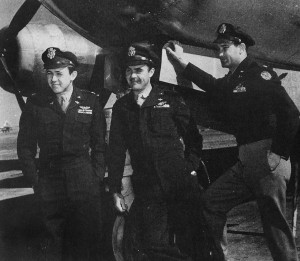
Col. Paul W. Tibbets, center, recruited Capt. Theodore J. Van Kirk, navigator, left, and Maj. Thomas W. Ferebee, bombardier, right, from his former B-17 crew for his “atomic air fleet.”
Tibbets was told they had reached the point in the development of the weapon where they needed him to organize and train a group to test-drop and later deliver those weapons. His job would also include recommending and supervising required modifications of the aircraft involved. Parsons, a Naval Academy graduate who was an associate director of the Los Alamos laboratory, in charge of atomic bomb ballistics, brought up the subject of how the bomb-carrying plane would be affected by shock waves, and discussed a new phenomenon known as radiation.
“I’m listening with my ears wide open,” said Tibbets.
As the conversation neared its end, Ent told Tibbets, “I don’t think I can tell you anymore. If anything comes up you want an explanation on, all you have to do is ask us. But, I’d advise you one thing—just a friendly gesture; don’t ask for anymore than you need to know.”
“I said, ‘Fine. I understand the principal,'” recalled Tibbets.
Finally, Ent said, “You’re going to have a hell of a lot of responsibility dumped on you, but you have a lot of authority to go with it. Be careful how you use it.”
Ent added he was confident of Tibbets’ ability, and that if the Second Air Force could help him in anyway, they would. Tibbets was also told he would have to conceal the nature of his work from everyone, even those with whom he would work and his family.
The Work Begins
Tibbets began his work immediately, selecting Wendover Army Air Base, on the Utah/Nevada border, as the base for his “atomic air fleet,” and approving Ent’s suggestion of the 393rd Bombardment Squadron, 504th Group, from Harvard, Neb., already training in B-29s, as the nucleus of the special air force.
To that squadron, he added men of his own choosing. Those men included former B-17 crewmembers such as Maj. Thomas W. Ferebee, bombardier; Capt. Theodore J. “Dutch” Van Kirk, navigator; Tech. Sgt. Wyatt E. Duzenbury, flight engineer; and Staff Sgt. George R. Caron, tail gunner, who would be assigned to his plane in the squadron and would be in charge of training their counterparts in the other aircraft.
He also selected Capt. Robert A. Lewis, who had been involved with him in B-29 testing, as his copilot. Of less than 50 people he chose by name, others included bombardier Kermit Beahan, navigator; and James van Pelt, radar specialist.
On Dec. 17, 1944, formal orders were issued activating the 509th Composite Group, later nicknamed “Tibbets’ Individual Air Force,” which included engineering, maintenance and technical units, military police and a medical unit with specialists in the field of radiology.
The Manhattan District attached a security organization to the group, whose job was to infiltrate every phase of the operation to be sure no information was leaked, even though all most were told was that they had been brought there to work on a “very special mission” that could end the war.
The Bombs
Tibbets would soon become acquainted with the bombs that were in development. “Fat Man” earned its name due to its bulbous, pumpkin-like shape, made necessary by its complicated firing mechanism. The bomb contained a sphere of plutonium, around which were arrayed blocks of high explosives designed to produce a highly accurate and symmetrical implosion.
An alternative to that complicated bomb was the comparatively slender “Little Boy,” whose mechanism was like that of a gun barrel, with a conventional explosive charge driving one slug of uranium into another.
As it became more evident that “Little Boy” would be the first used, scientists warned it would be unsafe to drop the 9,000-lb. bomb from an altitude of less than 30,000 feet, which translated to a little less than six miles above the ground, once over the target. Further calculations showed that in order to withstand the shock wave caused at detonation, the airplane needed to be at a distance of eight miles. It would be Tibbets’ task to increase the distance between blast and bomber.
The estimated time of how many seconds would pass between when the bomb left the airplane and when it detonated—at less than 2,000 feet above the ground—was 43. It would take the shock wave 43 seconds to travel eight miles. Estimations showed the airplane could travel the same amount of miles in two minutes.
Tibbets determined that a safe distance could be achieved by flying a little more than five miles in the “opposite” direction after bomb release.
To do that, he had a couple of tricks up his sleeve. Previously, he had been assigned to Grand Island, Neb., where, under Armstrong, he had started a school to train B-29 flight instructors. From there, he had been ordered to Alamogordo, to collaborate with Dr. E.J. Workman, a physics professor who had been involved in the theoretical study of the B-29’s vulnerability to attack by enemy fighter planes.
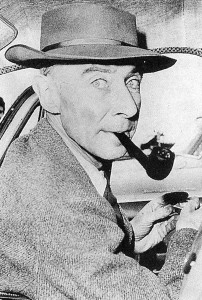
In late 1942, nuclear physicist J. Robert Oppenheimer, who came to the project from the University of California, Berkeley, was chosen to head a new laboratory devoted to designing atomic bombs, which opened in Los Alamos the following spring.
It was Tibbets’ job to put his theories to test through simulated combat with Republican P-47 Thunderbolts. He had been faced with the difficulty of maintaining control of the airplane while flying in the thin air that exists at high altitude, where a too-steep bank or a sudden movement to the controls might cause the plane to stall. They came to realize it would be almost impossible to fly the B-29, with a full complement of weapons and armor plating, at high altitude, in the tight formations they had used with Fortresses in raids over Europe.
However, one day, he was forced to borrow another aircraft, stripped down. The loss of turrets and other armament, with only the tail gun remaining, resulted in the elimination of “7,000 pounds of dead weight,” which in turn meant higher altitude, greater speed, better handling and fuel economy.
In further practice, he had discovered that the B-29 could now turn in a shorter radius than the smaller planes. In light of this, Tibbets decided the B-29 would be stripped of turrets and armor plating. True, they would be flying over enemy territory with little protection, but at 30,000 feet, they would be above the effective range of most antiaircraft fire.
He believed that the most effective maneuver would be for the pilot to make a sharp and fast diving turn of 155 degrees, which would have the bomb-carrying plane flying almost directly away from the pre-set aiming point. However, the move would put considerable strain on the airplane and require a degree of precision flying unfamiliar to bomber pilots. It would take lots of practice.
Tibbets would further specify that the bomb-carrying plane and others involved in the mission be fitted with fuel-injected engines and new technology reversible-pitch propellers.
The unusual cargo would require bomb bays to be reconfigured.
Even before receiving requisitioned new B-29s, pilots practiced over the desert near Wendover. At first, they used conventional practice bombs and dummy bombs to determine the ballistics. Later they used practice “pumpkin” bombs.
In the winter of 1944, Tibbets received permission to send crews to Batista Field near Havana, Cuba, where they could use various islands to make simulated bomb runs, while practicing the transition from over-water to over-land flying.
In March 1945, the First Ordnance Squadron, a unit designed to carry out the technical phases of the group responsibilities, became part of the 509th. The personnel count now exceeded 1,500 enlisted men and some 200 officers.
By April, a U.S. Navy blockade of Japan was nearly complete. On April 12, President Roosevelt died unexpectedly, and Vice President Harry S. Truman was sworn in, inheriting the project. He would come to believe that the atomic bomb would be the means of ending the war quickly, thus avoiding a costly invasion of Japan, and preventing casualties on the scale of “an Okinawa from one end of Japan to the other.”
In the meantime, an atomic bomb test had been scheduled for July. And, Tibbets had grown tired of waiting for word of his group’s move to the Pacific. They were being delayed while scientists quibbled over odds. “Little Boy’s” firing mechanism was so simple that scientists calculated the chances of failure at one in 10,000. But some thought the odds should be lengthened to a million to one. Noting that the acceptable odds for survival on their bombing raids in Europe had been 10 to one, Tibbets, by then 30 and a recent full colonel, commented on that subject.
“Hell, nothing is that certain,” he said.
He decided to take matters in his own hands. He knew the procedure; when an organization was ready, the commander called a certain number in Washington, D.C., and said, “We’re ready to be inspected.”
“I had this number to call,” he said. “All I had to do is say, ‘Silver Plate’s ready to go.’ In effect, I said, ‘Issue the orders for the 509th to be processed for overseas movement.”
Tibbets did that and received acknowledgement. Almost immediately, inspectors showed up and gave his men the thumb’s up. After a colorful chewing out from Groves, who hadn’t been asked about the decision, and who Tibbets decided, was only teaching him his place, members of the group were soon on their way to Tinian Island in the Marianas chain, thus putting pressure on the scientists to finish the job of getting the bomb ready.
The S.S. Cape Victory sailed on May 6, two days before V-E Day, with 1,200 of their people reaching its destination on May 29. Their advance air echelon of transport planes and other support aircraft arrived on May 18.
On May 9, 1945, Tibbets visited the Glenn L. Martin Company’s plant in Omaha, Neb., and picked his B-29 (45-MO-44-86292) off the assembly line, as well as requisitioning others from the production line. By the first week of July, 18 bombers had arrived at Tinian, after practice work at Wendover was completed.
They would immediately go through the modification process.
Tibbets himself flew to Tinian in mid-May for a personal inspection and to meet with Admiral Nimitz, commander in chief of the Pacific fleet, and to speak with Gen. Curtis LeMay. LeMay, at the time commander of the 20th Air Force, would become deputy to Gen. Carl Spaatz when the latter was named commander of the newly created Strategic Air Forces in the Pacific. However, up to that point, he had been told only minimal information about the project. Tibbets updated LeMay on the project in LeMay’s “intelligence room,” actually half of the mess hall, hidden behind velvet drapes.
In the room, LeMay immediately pointed out pictures on easels showing bomb damage from firebombs dropped by B-29s, an idea inspired by Tibbets when LeMay visited Grand Island, Neb., previously. At that time, during a conversation between LeMay, Tibbets and Armstrong—later to be commander of the 315th Bomb Wing, of which the 509th would become theoretically a part—LeMay asked what was to be done with the problematic B-29, and Tibbets had said they should be stripped down, and flown at night to drop firebombs.
“He said, “You’re crazy as hell,” recalled Tibbets, but he had later taken the advice.
“That made his reputation,” said Tibbets. “He knew that, and he knew I knew that.”
After Tibbets had given LeMay a rundown on the progress with the A-bomb, LeMay had one big question left.
“Think the damn things will work?” he asked.
“Yeah, I think they will,'” Tibbets had said.
By the time of that recent meeting, the 509th, self-contained, included the 393rd Bomber Squadron, the 320th Troop Carrier Squadron, the 390th Air Service Group, the 603rd Air Engineering Squadron, the 1027th Air Materiel Squadron, and the First Ordnance Squadron, made up mostly of highly skilled specialists in charge of handling the atom bombs when they arrived. The 509th lived in relative isolation near North Field, one of two air bases on the island.
From off of what was said to be the longest operational runways in the world at the time, heavy loads of bombs and fuel were carried nightly on 14-hour round-trip flights to the enemy homeland.
Inevitably, the word got around the island that the group—who surprisingly got speedy response to their every requisition—earning them the reputation of a “bunch of pampered dandies”—were involved in something special. But when days passed and nothing happened, and the group offered no explanation except that they were there to “win the war,” the group was soon the object of taunts.
Tibbets described them as a “different breed of cat.”
For the first two or three weeks after arriving, his crews engaged in routine training or familiarization flights, dropping conventional bombs on islands still in enemy hands. However, he says he was later told to keep his crews out of training classes, because they knew more than instructors did.
Target
It was the job of Groves’ Target Committee to draw up a list of recommendations.
At the first target discussion, preference was expressed for Kyoto, Hiroshima, Yokohama and Kokura. By the end of May, due to a more detailed study, Niigata had replaced Kokura on the list.
Later, the top choice of the committee was removed when Secretary of War Henry Stimson vetoed Kyoto, citing it was the ancient capital of Japan, as well as a historical city of great religious significance to the Japanese. In July, the port city of Nagasaki was added instead. Although firebombing of other cities took place, the Army Air Forces ordered cities on the list to remain undamaged.
On May 31, 1945, members of the Interim Committee on post-war atomic policy met. The discussion included if Japan should be warned of the dropping of the atomic bomb, giving them time to evacuate the target, and arranging a demonstration of the bomb for delegates from Japan. Both ideas were rejected. It was reasoned that if warned, the Japanese might try to shoot down the bomber or move prisoners of war into the target area. As for a “demonstration,” it would be embarrassing if nothing happened. One idea that was agreed on was that to ensure an accurate drop, the bombing would occur in daylight and clear weather.
The Manhattan Project was so secret that most military planners were unaware of it. With that in mind, the War Department continued to assume that an invasion would be necessary to force Japan to surrender.
On June 18, 1945, Truman gave preliminary approval to invasion plans presented by Gen. George C. Marshall, Army Chief of Staff, an important adviser to Roosevelt and Truman on the Manhattan Project. Operation Downfall, if it took place, would have two parts. In Operation Olympic, planned for early November, about 800,000 Marines and Army troops would begin landing on the beaches of the southern island of Kyushu. If the Japanese didn’t then surrender, Kyushu would be used as an air base and staging area for Operation Coronet, an amphibious landing on the main island of Honshu, to begin in spring 1946. A huge force of 28 divisions, twice the size of Olympic, would eventually come ashore on beaches near Tokyo. Those who argued against an invasion pointed out the terrible casualties of the Okinawa campaign, where 48,000 American had died or been wounded. However, Marshall and his staff believed that, as with Germany, only the occupation of the enemy’s territory and capital would end the war. That is, if it wasn’t ended first by the dropping of an atomic bomb.
As plans proceeded for the invasion, only a few knew that the elaborate plans would probably not be carried out, and that preparations were underway for the deployment of the atomic bomb.
On July 16, 1945, Allied leaders assembled for the Potsdam Conference, called to discuss the peace settlement in Europe and to issue a surrender ultimatum to Japan. There, Stalin—interested in joining the Pacific war, so he could bring China and Korea into the Soviet sphere and share in the occupation of Japan—and Truman discussed Tokyo’s new diplomatic approaches to Moscow, which indicated Emperor Hirohito’s search for a compromise peace that might allow Japan to retain some of its overseas territories.
On that same day, the first atomic bomb was tested in the New Mexico desert near Alamogordo. The explosion, equal to that of 20,000 tons of TNT, was many times larger than what had been expected.
On July 25, one day before the issuance of the Potsdam Declaration, which demanded the surrender of the Japanese Empire, Thomas Handy, the acting Army Chief of Staff in Washington, issued the order to Lt. Gen Spaatz, at his request, authorizing the use of the bomb.
On the morning of July 26, at Tinian, the cruiser Indianapolis dropped anchor and unloaded a 15-foot wooden crate onto the deck of an LST, containing the firing mechanism for the bomb and a lead cylinder containing a slug of uranium. Both were taken to the bomb assembly hut, for fitting into a casing previously supplied. A second slug of uranium was still needed to complete the explosive elements of the bomb. This was put aboard a B-29 at Hamilton Air Force Base in California on the day the cruiser delivered its cargo on Tinian. Two other B-29s, with plutonium for the second bomb, left at the same time.
In the meantime, on July 28, Prime Minister Suzuki announced that his government would ignore the declaration. On July 29, Spaatz arrived on Guam. He brought with him the order that had been drafted in Washington by Groves, authorizing the dropping of “the first special bomb” on one of four cities: Hiroshima, Kokura, Niigata or Nagasaki. No specific date was set, but it indicated the mission would take place after Aug. 3.
At a meeting with Spaatz and others, Tibbets assured them they were ready. Then, on the basis of the orders received from Groves, he drafted a more detailed one and sent it to LeMay. On Aug. 3, it came back, with LeMay’s signature authorizing “Special Bombing Mission 13.” The 12 previous “special missions” had been the group’s flights to Japan with non-atomic “pumpkins.”
In the meantime, on July 30, just after midnight, a Japanese submarine torpedoed and sank the USS Indianapolis, which, after delivering atomic bomb material to Tinian, was en route to the island of Leyte. Of 1,196 crewmembers (sailors and Marines), 900 initially survived, but only 316 were alive when, on Aug. 4, a member of an anti-submarine patrol spotted the wreckage.
Since the day the order had been authorized, clouds had hung over the Japanese islands. On Aug. 5, they were just beginning to break up, when a Teletype machine—brought into the area so that Brig. Gen. Thomas F. Farrell, the Manhattan District’s ranking officer on the scene, could keep in touch with Groves—began sending a message.
“They were saying, ‘Go ahead and use the bombs.’ Truman has approved it,” Tibbets recalled.
He would soon be making last-minute preparations for a monumental mission that would change the course of history.
A Rendezvous With History (part 3)











